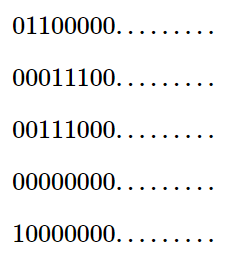| Codeforces Round 737 (Div. 2) |
|---|
| Finished |
Moamen was drawing a grid of $$$n$$$ rows and $$$10^9$$$ columns containing only digits $$$0$$$ and $$$1$$$. Ezzat noticed what Moamen was drawing and became interested in the minimum number of rows one needs to remove to make the grid beautiful.
A grid is beautiful if and only if for every two consecutive rows there is at least one column containing $$$1$$$ in these two rows.
Ezzat will give you the number of rows $$$n$$$, and $$$m$$$ segments of the grid that contain digits $$$1$$$. Every segment is represented with three integers $$$i$$$, $$$l$$$, and $$$r$$$, where $$$i$$$ represents the row number, and $$$l$$$ and $$$r$$$ represent the first and the last column of the segment in that row.
For example, if $$$n = 3$$$, $$$m = 6$$$, and the segments are $$$(1,1,1)$$$, $$$(1,7,8)$$$, $$$(2,7,7)$$$, $$$(2,15,15)$$$, $$$(3,1,1)$$$, $$$(3,15,15)$$$, then the grid is:

Your task is to tell Ezzat the minimum number of rows that should be removed to make the grid beautiful.
The first line contains two integers $$$n$$$ and $$$m$$$ ($$$1 \le n, m \le 3\cdot10^5$$$).
Each of the next $$$m$$$ lines contains three integers $$$i$$$, $$$l$$$, and $$$r$$$ ($$$1 \le i \le n$$$, $$$1 \le l \le r \le 10^9$$$). Each of these $$$m$$$ lines means that row number $$$i$$$ contains digits $$$1$$$ in columns from $$$l$$$ to $$$r$$$, inclusive.
Note that the segments may overlap.
In the first line, print a single integer $$$k$$$ — the minimum number of rows that should be removed.
In the second line print $$$k$$$ distinct integers $$$r_1, r_2, \ldots, r_k$$$, representing the rows that should be removed ($$$1 \le r_i \le n$$$), in any order.
If there are multiple answers, print any.
3 6 1 1 1 1 7 8 2 7 7 2 15 15 3 1 1 3 15 15
0
5 4 1 2 3 2 4 6 3 3 5 5 1 1
3 2 4 5
In the first test case, the grid is the one explained in the problem statement. The grid has the following properties:
- The $$$1$$$-st row and the $$$2$$$-nd row have a common $$$1$$$ in the column $$$7$$$.
- The $$$2$$$-nd row and the $$$3$$$-rd row have a common $$$1$$$ in the column $$$15$$$.
In the second test case, the given grid is as follows:

| Name |
|---|




